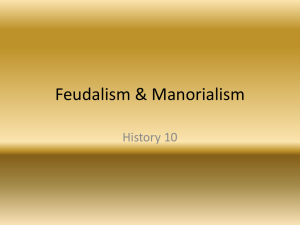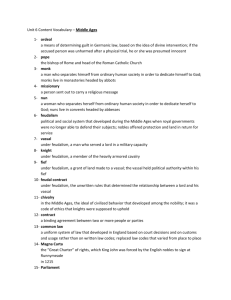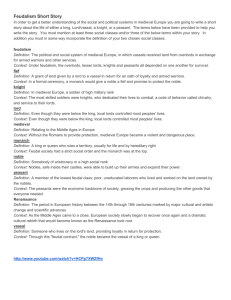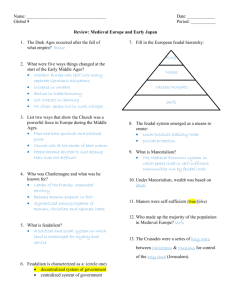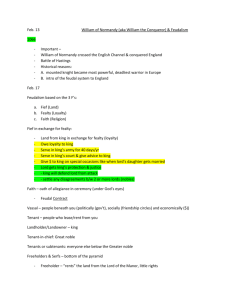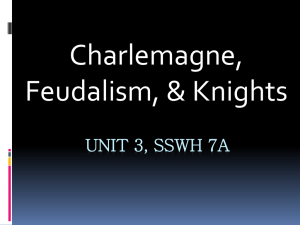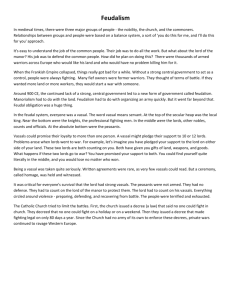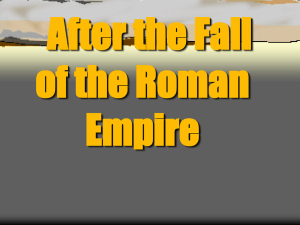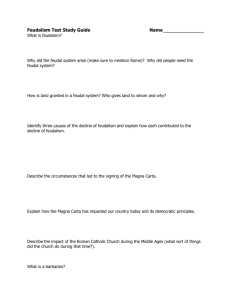Medieval life
advertisement
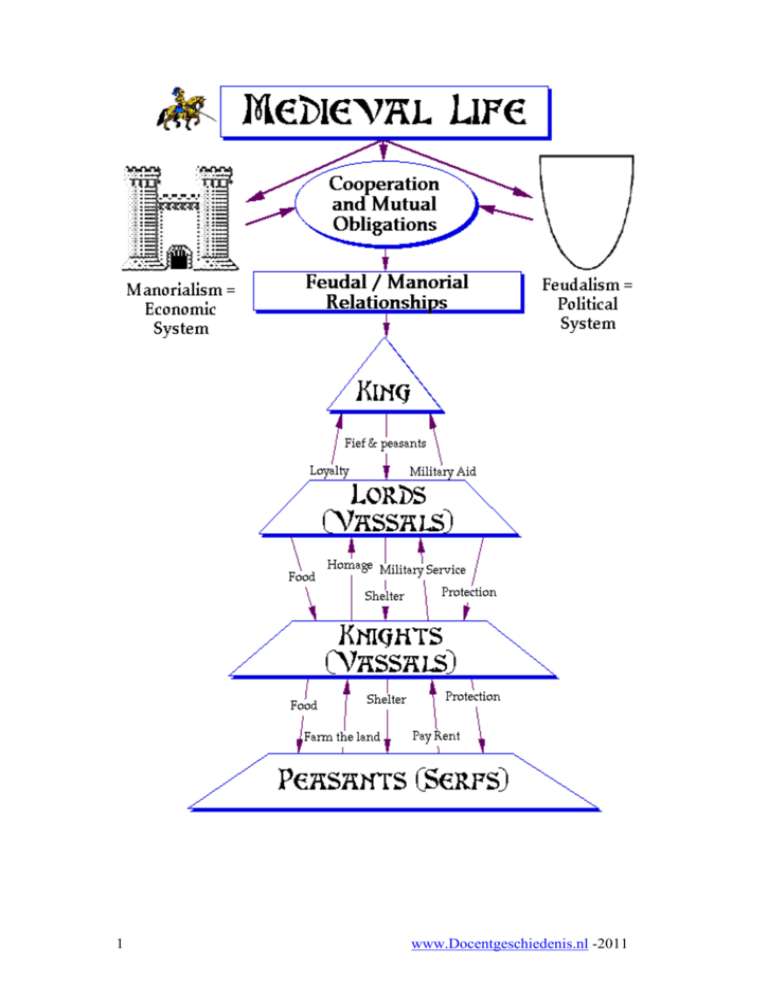
1 www.Docentgeschiedenis.nl -2011 Feudalism / Manorialism Feudalism was the system of loyalties and protections during the Middle Ages. As the Roman Empire crumbled, emperors granted land to nobles in exchange for their loyalty. These lands eventually developed into manors. A manor is the land owned by a noble and everything on it. A typical manor consisted of a castle, small village, and farmland. During the Middle Ages, peasants could no longer count on the Roman army to protect them. German, Viking and Magyar tribes overran homes and farms throughout Europe. The peasants turned to the landowners, often called lords, to protect them. Many peasants remained free, but most became serfs. A serf was bound to the land. He could not leave without buying his freedom, an unlikely occurrence in the Middle Ages. Life for a serf was not much better than the life of a slave. The only difference was that a serf could not be sold to another manor. Serfs would often have to work three or four days a week for the lord as rent. They would spend the rest of their week growing crops to feed their families. Under the system of medieval European feudalism, a fiefdom ( fief, feud ), often consisted of inheritable lands or revenue-producing property granted by a liege lord, generally to a vassal, in return for a form of allegiance, originally to give him the means to fulfill his military duties when called upon. A vassal is one who enters into mutual obligations with a king or liege lord, usually of military support and mutual protection, in exchange for certain guarantees, as a fief. Feudalism was not a word used in the middle ages. It has had two quite distinct meanings in recent usage. The first meaning - promoted by radicals during the French Revolution and developped by Marxist historians - refers to a social system based on a society in which peasant agriculture is the fundamental productive activity; in which slavery is non-existent or marginal but peasants are tied to the land in some way; and in which a small elite defined by military activity dominates. This is probably the most important meaning in modern popular usuage. For most of the 20th-century, professional medievalists have given the term a quite different meaning. For medieval historians the term has come to mean a system of reciprocal personal relations among members of the military elite, which lead ultimately to parliament and then Western democracy. For modern historians, the older "Lord and peasant" model was subsumed in the concept of manorialism. Feudalism was the political and economical system of Europe from the ninth to fifteenth century, based on the holding of all land in fief and the resulting relationship of lord to vassal characterized by homage, legal and military service of tenants. Manorialism was the organizing principle of rural economy and society widely practiced in medieval western and parts of central Europe. Manorialism was characterised by the vesting of legal and economic power in a lord, supported economically from his own direct landholding and from the obligatory contributions of a legally subject part of the peasant population under his jurisdiction. These obligations could be payable in several ways, in labor, in kind, or, on rare occasions, in coin. The historian Susan Reynolds, in her Fiefs and Vassals, systematically attacked the basis of the professional medievalists' version of feudalism. Reynolds argued that recent historians had been too ready to read back 11th- and 12th-century legal texts (which do use feudal) terminology onto a much more variated 9th- and 10th century society and had ended up creating a "feudal world" which simply did note exist, or which, at most, described small parts of France for short periods 2 www.Docentgeschiedenis.nl -2011 1.) Feudalism in Europe, 5 minutes ( watch for the first time ): http://www.youtube.com/watch?v=k3aNlvQxvbs&feature=youtu.be 2.) Fill in the gaps using the the video, text and model about medieval life: Fief, Lord, Vassal, Serf, Shelter, Loyalty, Homage, Feudalism, Manorialism, Knight. A.)The more agricultural and less military part of the feudal / manorial system:................ B.) Land given away in return for services:................ C.) Faithfulness or a devotion to a person or cause:................. D.) A worker usually under a lord. Not a slave:................... E.) The more military and less agricultural part of the feudal / manorial system:.................... F.) A promise to follow a lord loyally; the contract between a lord and vassal.:...................... G.) One who serves a lord in a military capacity:..................... H.) A military leader and land owner who reigns over vassals:........................ I.) A mounted warrior, heavily armored, sometimes with a lance:....................... J.) A place where one can be safe:..................... 3.) Answer the questions using the video, text and model about medieval life: 1) 2) 3) 4) 5) 6) 7) 8) 9) 10) What is feudalism? What is a manor? What are lords and peasants? What is the difference between serfs and slaves? Can you describe a fiefdom ( fief, feud )? What could be given by a king or liege lord to his vassal, in exchange for military duties? What are mutual obligations and what do they have to do with kings, liege lords and vassals? What is manorialism? Can you explain the difference between feudalism and manorialism in your own words? What does Susan Reynolds have to say about the ‘feudal world’? 4.) Feudalism in Europe, 5 minutes ( watch for the second time ): http://www.youtube.com/watch?v=k3aNlvQxvbs&feature=youtu.be 3 www.Docentgeschiedenis.nl -2011 5.) Linking Exercise. 4 www.Docentgeschiedenis.nl -2011
